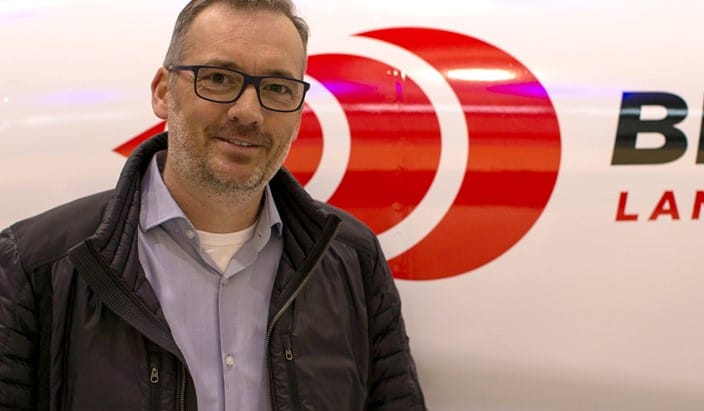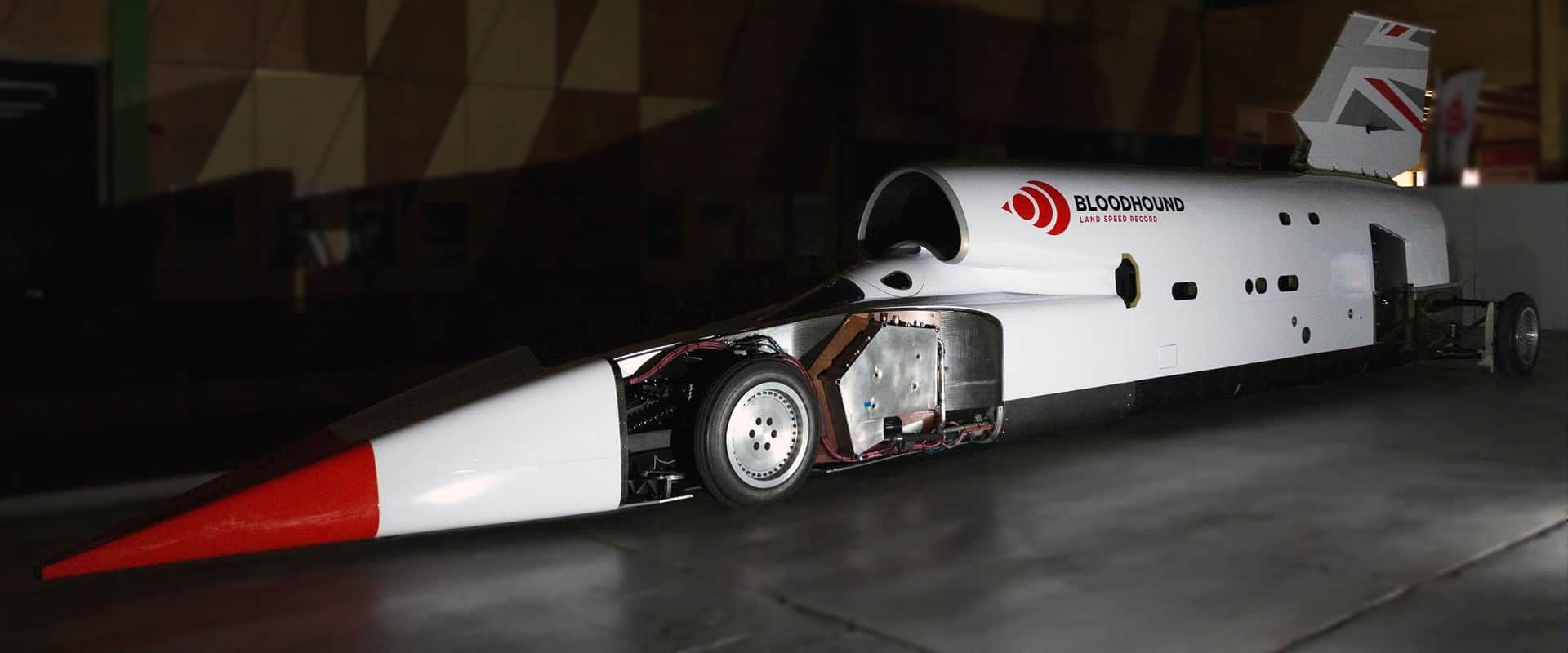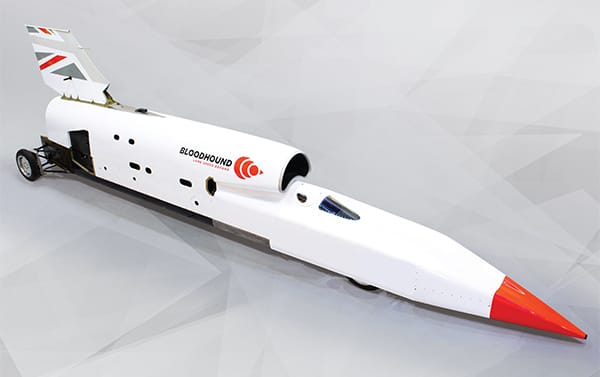earlier this month (July 10th 2019) Bloodhound, the car designed for Britain’s next assault on the world land speed record, is set for high-speed tests in South Africa this autumn.
The news is a welcome sign that the project is back on track following its rescue late last year (2018) by Yorkshire businessman Ian Warhurst.
Earlier this summer The Engineer spoke to Warhurst about his involvement in the project and his plans for the future.

How did you end up buying Bloodhound?
I thought I’d retired. I’ve been running my own business for the last 16 years (Turbocharger specialist Melett). I sold the business in 2017 and retired officially at the end of November. I had no plans to do anything other than take it easy and enjoy life.
I’d been following the Thrust SSC project back in the 90s and thought it was fantastic, and I’d been following Bloodhound. I became a member of the 1k club (the supporters club) in 2009. My son came here to the NEC to do a STEM rocket car challenge and he thought it was great, so I knew the project was doing a really good job inspiring new engineers.
If I hadn’t done a deal the next man in that building was the man with the angle grinder coming to break it all up, so I did a deal
When I heard the project had gone into administration in October I was very disappointed like everybody but I also thought “well, it’s gone under covers, it needs a bit of break to get more sponsorship, I’m sure it’ll reappear and carry on.”
Then I was sitting at home one Friday night in December and my son Charlie sent me a text and said “Hey dad have you seen the Bloodhound car’s for sale? Why don’t you go and buy it ha ha ha!” So, I googled Richard Noble and sent him an email saying, “Hi Richard, you don’t know me, but I’ve got a few quid can I help?” and he came straight back.

I spoke to the administrators on the Monday, went down on the Tuesday and I realise that the problem was that the car has some military-controlled equipment in it and that had to come out because the MOD had gotten wind of the fact that the administrators were going to cut up the car and sell it off.
The MOD were banging the door down trying to get in to take their stuff out, and the administrators couldn’t get it out because it was very deep inside the car so they came to the conclusion the only way of getting this thing out was getting an angle grinder and cutting the car in half.
I knew when I left that building if I hadn’t done a deal the next man in that building was the man with the angle grinder coming to break it all up, so I did a deal. On Wednesday we were talking to each other; on Thursday I was confirming the contract and on Friday morning I signed up, job done. I then owned this massive long car!”
What’s your role in the project?
I initially thought I’d buy the car, ring-fence the assets and hold it together in one place so that no one bit could disappear, and the project could rebuild and regroup.

I was supposed to be the man with the money helping out not running the project but the more I got involved the more I found myself having to get the team together; having to find out more about the car; having to find a building to put it in. And because it was my money, I was spending I felt I’d like to look after what I was spending so I ended up almost naturally stepping into the role and I’m now full-blown running the project
Whilst I’m CEO the key people are also still in place: Andy Green is still driving the car; Mark Chapman is still the chief engineer and he knows the car absolutely inside out. Everybody’s getting on with the job now and I’m just overseeing the project and giving them some direction and some money.
What’s the economic model for the project now that you’re running it?
The problem the project had in the past was it was not supposed to take 10 years, it was supposed to take 3 or 4. It ended up costing huge amounts more than we first anticipated and when you’re trying to sell sponsorship you can only sell the space on a car once. It got to the point where there was no space left to sell and because it kept not hitting deadlines people were less and less interested in sponsoring it, so it went into a bit of a downward spiral.
Having effectively bought the car out of a skip I’ve got a new company, and all the original sponsor deals were with the original company. We like to think the original sponsorship was for the design and build phase of the project. What we’re looking at now is the running phase of the project which is a different part of the project. To commercialise this I want to be able to find new sponsors.
The question is what’s it going to cost to get to the desert and do something and what do we think the value of sponsorship is worth on the car? After we did some analysing we estimated the value to run the car to land speed record would be covered by the cost of sponsoring the car.
I’m 100 per cent committed to get this car to the desert for the high-speed testing. We’re already having great conversations with sponsors - existing and new - and I’m very comfortable this will become sponsored. The most important thing my money is doing is providing cashflow and that gives certainty to sponsors.
Are you proposing any fundamental changes to the core technology?
Fundamentally it’s still an EJ200 jet engine with a monopropellant rocket. The one thing that is changing is that the rocket motor was originally run with a JLR V8 engine, and we’re looking to electrify that. From a safety point of view, you don’t want to mix hydrogen peroxide with anything organic like oil. At the time when it was designed the technology didn’t exist to electrify the motors but because it’s gone on for 10 years the technology now exists.
When will the rocket be integrated?
That ties in with what we’re doing at the moment. I’ve split the project into 2 parts: Land Speed Record and Maximum design speed.
Everyone bills this as the 1000mph car, but that’s the second phase. That allows us to focus clearly on the land speed record, understand the costs involved in that and focus on that part of the project. That’s because the rocket required to get to maximum design speed needs a big redesign of the back end of the car. It doesn’t fit in the current configuration.
When do you hope to go for the record?
One of the problems the project had last time was they kept making dates in the hope it would happen to try and bring sponsors on board but then didn’t hit the date. I prefer the under promise and over deliver approach, but at the moment our plan is to get to the desert this year.
Is STEM engagement still an important part of the project?
I got involved in this because of the STEM. Britain needs more engineers. What’s been fantastic about this project is the inspiration it gives to people to get into engineering. Because it’s been going 10 years there are people who were inspired back in 2010 who are now engineers.
Bloodhound Education (the STEM arm of the project) never stopped - they were carrying on through the administration - and we’re working with them to help that carry on.
Beyond its STEM impact do you think Bloodhound will have any technological spin-offs?
Clearly no one wants to go to the shops in a 1000mph car, but the technology behind it is pushing the boundaries and taking us to places we don’t go. The great thing about that is if you don’t do these things, you don’t’ go there, and you won’t find out what happens when you do get there.
Will you have a ride in it yourself?
I don’t want to go in it myself. It’s really scary!





Nanogenerator consumes CO2 to generate electricity
Whoopee, they've solved how to keep a light on but not a lot else.